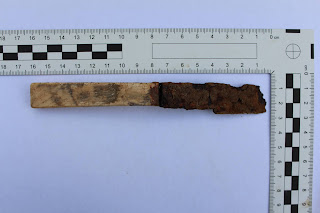Saturday, 11 September 2021
Season's End
Fancy a tipple?
Tuesday, 7 September 2021
Keep it buttoned
Special Find of the Day:
In 1774 a foul anchor surrounded by rope
edging took the place of a rose and in 1787 the same device, with the addition
of a wreath of laurel leaves, was adopted for Admirals. When the Merchant Navy
started to use the foul anchor device a crown was added for all naval officers
in 1812. The same basic design remains in use today.
The
foul anchor device itself was first recorded in use in the seal of the Lord
High Admiral of Scotland in 1402. It was subsequently adopted in the Admiralty
seal and by a large number of navies throughout the world. The rope 'fouling'
has no specific twist and may be deemed to be correct however it fits around
the anchor.
It is nice to think that someone from the navy visited Stalbridge House and then lost a button!
Monday, 6 September 2021
Get stuck in
- Early 17th century - Forks became commonplace across Europe as a tool of steadying food while cutting, and in a lesser case for providing easier transfer of solid food between the plate and mouth. Majority of people still used sharply pointed knives for that purpose.
- 1630 - Forks and blunt tipped knives start arriving at colonies in North America.
- 1669 - French King Louis XIV of France banned the use of sharp tipped knives in France as a means of reducing violence. This introduced new era of blunt tipped eating knives.
Windy Waddon
DDCAG members are helping Bournemouth University to unearth more information about the site of Waddon Hill, a Roman barracks and possible Ir...

-
Two worked stones that could be the top corners of a doorway. The drain turns at a right angle and heads south. Capping stones ...
-
Yesterday some of the group were back in Nether Compton investigating a curious flat surface in a gentleman's back garden. It gave us th...
-
Martin (left) and WDDAG WDDAG visited Martin Green's Down Farm this weekend, and what an experience it was! He took us through ...






